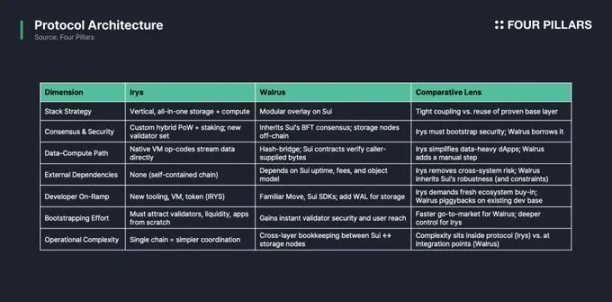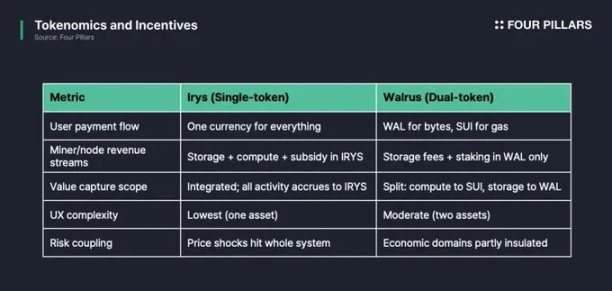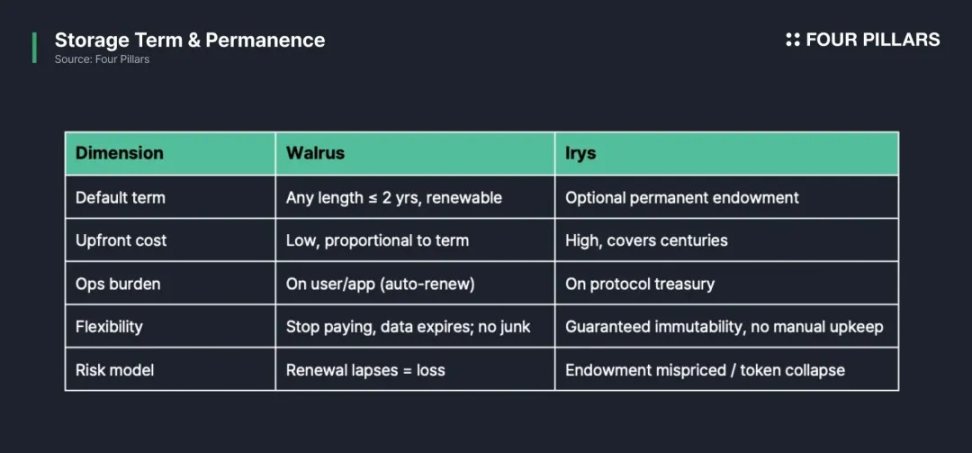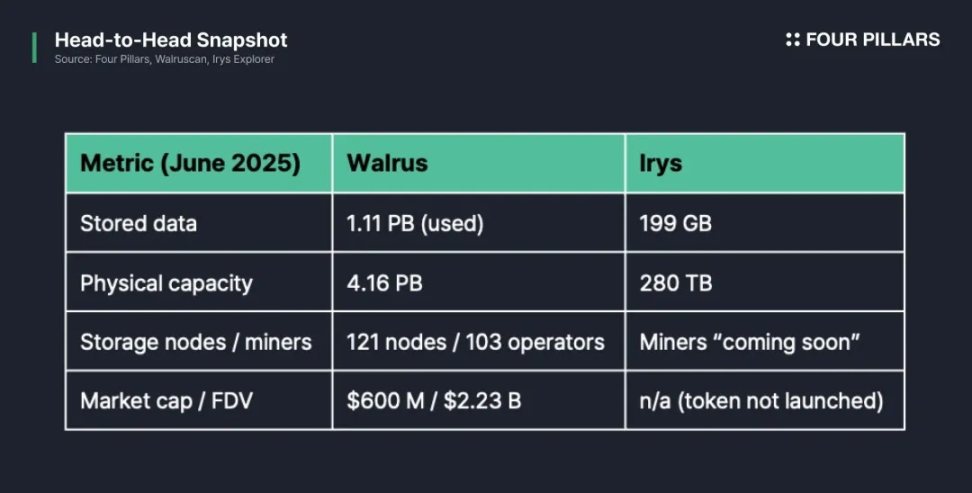Written by: Ponyo
Compiled by: Sui Network
Summary of key points
🔧 Architecture: Irys is a fully functional, all-in-one Layer 1 “datachain” that provides native blob access to contracts, but requires a whole new set of validating nodes. Walrus is an erasure coded storage layer built on Sui that is easier to integrate, but requires cross-layer coordination.
💰 Economic model: Irys uses a single token, IRYS, to unify payment fees and rewards. The user experience is simple, but the risk of price fluctuations is high. Walrus divides the functions into two tokens: WAL (for storage) and SUI (for gas), which can effectively isolate costs, but requires maintaining two incentive systems.
📦 Persistence and computing power: Irys maintains 10 complete copies and streams data directly into its virtual machine; Walrus uses erasure coding with about 5 times redundancy plus hash verification, which has a lower storage cost per GB, but the protocol implementation is more complex.
💾 Adaptability: Irys provides a "pay once, store forever" donation model, which is very suitable for preserving immutable data, but the initial cost is high. Walrus adopts a "pay as you go, automatic renewal" leasing mechanism, which is easy to control costs and can be quickly integrated with Sui.
📈 Adoption: Although Walrus is still in its early stages, it is developing rapidly, with PB-level storage, 100+ node operators, and has been adopted by multiple NFT and game brands. In contrast, Irys is still in the pre-expansion stage, the data volume has not reached the PB level, and the node network is still growing.
Walrus and Irys are both committed to solving the same problem: providing reliable, incentivized on-chain data storage. However, their design concepts are completely different: Irys is a Layer 1 blockchain specifically built for data storage, integrating storage, execution, and consensus into a vertically integrated architecture; while Walrus is a modular storage network that relies on Sui for coordination and settlement, while running an independent off-chain storage layer.
Although the Irys team initially described it as a better "built-in" solution and defined Walrus as a limited "external" system, in reality both have their own advantages and disadvantages, and different trade-offs. Based on a technical perspective, this article objectively compares Walrus and Irys in 6 dimensions, refutes one-sided assertions, and provides developers with a clear selection guide to help them decide the most appropriate path based on cost, complexity, and development experience.

1. Protocol Architecture

1.1 Irys: Vertically Integrated L1
Irys embodies the classic "self-sufficiency" concept. It comes with its own consensus mechanism, staking model, and execution virtual machine (IrysVM), which are tightly integrated with its storage subsystem.
The verification node plays three roles at the same time:
Store user data in full copy;
Execute smart contract logic in IrysVM;
The network security is protected through the PoW + staking hybrid mechanism.
Since these functions coexist in the same protocol, every layer from block headers to data retrieval rules can be optimized for large-volume data processing. Smart contracts can directly reference on-chain files, and storage proofs will follow the consensus path for sorting ordinary transactions. The advantage lies in the high consistency of the architecture: developers only need to face a single trust boundary, a single fee asset (IRYS), and the experience of reading data in the contract code is like native support.
But the price is the high startup cost. A brand new layer 1 network must recruit hardware operators, build indexers, launch block browsers, harden clients, and cultivate development tools from scratch. In the early days when the verification nodes were not yet strong, the block time guarantee and economic security lagged behind the old chains. Therefore, Irys' architecture chose a deeper level of data integration at the expense of the speed of ecological startup.
1.2 Walrus: Modular Overlays
Walrus takes a very different path. Its storage nodes run off-chain, while Sui's high-throughput L1 handles ordering, payments, and metadata through Move smart contracts. When a user uploads a blob, Walrus shards it and stores it in each node, then records an on-chain object on Sui containing the content hash, shard allocation, and lease terms. Renewals, penalties, and rewards are all executed as normal Sui transactions, paying gas with SUI, but using WAL tokens as the storage economic settlement unit.
With Sui, Walrus immediately gained the following advantages:
Proven Byzantine Fault Tolerant consensus mechanism;
Complete development infrastructure;
Powerful programmability;
A basic token economy with liquidity;
Many existing Move developers can integrate directly without the need for protocol migration.
But the cost is the need for cross-layer coordination. Every lifecycle event (upload, renewal, deletion) must be coordinated between two semi-independent networks. Storage nodes must trust the finality of Sui while maintaining performance when Sui is congested; and Sui verification nodes do not review whether the actual disk stores the data, so they must rely on Walrus's cryptographic proof system to ensure accountability. Compared to an integrated design, this architecture inevitably has higher latency, and part of the handling fee (SUI gas) will flow to roles that do not actually store data.
1.3 Design Summary
Irys adopts a vertically integrated monolithic architecture, while Walrus is a horizontally layered integrated modular solution. Irys has greater architectural freedom and a unified trust boundary, but it needs to overcome the ecological construction difficulties brought about by cold start. Walrus, with the help of Sui's mature consensus system, has greatly reduced the access threshold for developers in the existing ecosystem, but it must deal with the coordination complexity of the two economic domains and operator systems. There is no absolute advantage or disadvantage between the two models, but the optimization direction is different: one pursues consistency (coherence), and the other pursues composability (composability).
When protocol selection depends on developer familiarity, ecological appeal, or speed of launch, Walrus's layered model may be more realistic. When the bottleneck lies in the deep coupling of data and computing, or customized consensus logic is required, Irys, a chain designed specifically for data, has enough reason to bear a heavier architectural burden.
2. Token Economy and Incentive Mechanism

2.1 Irys: One token drives the entire protocol stack
Irys’ native token IRYS covers the economic model of the entire platform:
Storage fees: Users prepay IRYS to store data;
Execution gas: All smart contract calls are also priced in IRYS;
Miner rewards: Block subsidies, storage proofs, and transaction fees are all paid in IRYS.
Since miners are responsible for both data storage and contract execution, computing income can make up for the lack of storage income. In theory, when DeFi activity on Irys is strong, computing income will offset data storage, thereby achieving services close to cost price; if contract traffic is low, the subsidy mechanism will be adjusted in the opposite direction. This cross-subsidy mechanism helps balance miner income and align incentives for various roles in the protocol. For developers, a unified asset means fewer custody processes and a more streamlined user experience, especially for scenarios where users are not expected to be exposed to multiple tokens.
But the disadvantage is the risk linkage of a single asset: once the price of IRYS falls, the rewards for computing and storage will decrease simultaneously, and miners will face a double squeeze. The economic security of the protocol and data persistence are therefore tied to the same price fluctuation curve.
2.2 Walrus: Dual Token Economic Model
Walrus splits functional responsibilities into two tokens:
$WAL: The economic unit of the storage layer. Users use WAL to pay for leasing space, and node operators receive WAL rewards by staking and storing data fragments. The rewards are also linked to the entrusted staking weight.
$SUI: Gas token used to coordinate transactions on the chain. Any transaction on Sui, such as uploading, renewal, and punishment, will consume SUI and be rewarded to Sui verification nodes, not Walrus storage nodes.
This separation keeps the storage economics clear: the value of WAL is only affected by data storage needs and lease periods, and will not be disturbed by DEX transactions or NFT crazes on Sui. At the same time, Walrus can also inherit Sui's liquidity, cross-chain bridges, and fiat currency entry-most Sui builders already hold SUI, so the marginal cost of introducing WAL is low.
However, the dual-token model also has the problem of incentive split. Walrus nodes cannot participate in SUI's fee income, so the price of WAL must be sufficient to independently support hardware, bandwidth and return expectations. If the price of WAL stagnates and SUI gas soars, the user's usage cost will increase, but the storage party will not directly benefit. On the contrary, the outbreak of DeFi on Sui has driven the income of verification nodes, but it has nothing to do with Walrus nodes. Therefore, to maintain long-term balance, it is necessary to actively optimize the economic model: storage prices need to float flexibly according to hardware costs, demand cycles and WAL market depth.
2.3 Design Summary
In short, Irys provides a unified and concise user experience, but centralizes risk; Walrus draws clear boundaries at the token level, bringing more sophisticated economic accounting, but needs to deal with two market systems and fee diversion issues. Builders should weigh whether they prefer a seamless experience or separate management of economic risks to match their own product planning and funding strategies.
3. Data persistence and redundancy strategy

3.1 Walrus: Using erasure codes to achieve lightweight and high reliability
Walrus splits each data block (blob) into k data shards and adds m redundant check shards (using the RedStuff encoding algorithm). This technology is similar to RAID or Reed-Solomon encoding, but is optimized for decentralized and high-node-change environments. You only need to take k of the k + m shards to reconstruct the original file, which brings two advantages:
High space efficiency: Under typical parameters (about 5 times expansion), the required storage space is reduced by half compared to the traditional 10 times replica replication scheme. Simply put, to store 1GB of data on Walrus, the overall network capacity requires about 5GB (distributed storage in shards on multiple nodes), while a traditional full-copy system may require 10GB to achieve similar security.
Strong on-demand repair capability: Walrus's encoding method not only saves space, but also bandwidth. When a node loses connection, the network only rebuilds the missing shards instead of the entire file, greatly reducing bandwidth overhead. This self-healing mechanism only needs to download data approximately equal to the size of the lost shard (i.e. O(blob_size/number of shards)), while traditional replication systems usually require O(blob_size) data.
The allocation of each shard and node will exist as an object on Sui. Walrus rotates the staking committee every epoch, challenges node availability through cryptographic proofs, and automatically recodes when node loss exceeds the security threshold. Although this mechanism is complex (involving two networks, multiple shards, and frequent verification), it can achieve the highest durability with the minimum capacity.
3.2 Irys: Conservative but robust multi-copy mechanism
Irys deliberately chose a more primitive and direct durability method: 10 staked miners each store a complete copy of each 16TB data partition. The protocol introduces the "salt value" (Matrix Packing technology) of specific miners to prevent duplicate entry into the same hard disk. The system will continuously read and verify the node hard disk through "proof-of-useful-work" to ensure that every byte really exists, otherwise the miner will be punished and the staked assets will be deducted.
In actual operation, whether the data is available depends on: Does at least one of the 10 miners respond to the query? If a miner fails to verify, the system will immediately start re-replication to maintain the standard of 10 copies. The cost of this strategy is up to 10 times the data storage redundancy, but the logic is simple and clear, and all states are concentrated on one chain.
3.3 Design Summary
Walrus focuses on: using efficient coding strategies and Sui's object model to deal with the frequent node replacement problem, thereby ensuring data persistence without increasing costs. Irys believes that as hardware costs drop rapidly, a more direct and heavier multi-copy mechanism is more reliable and worry-free in actual projects.
If you need to store PB-level archive data and can accept higher protocol complexity, Walrus's erasure code has a greater advantage in terms of economic per byte. If you value simplicity of operation and maintenance (one chain, one proof, sufficient redundancy) and believe that hardware expenditure is negligible relative to product delivery speed, Irys's 10-copy mechanism can provide durability with minimal thought.
4. Programmable Data and On-Chain Computing

4.1 Irys: Smart contracts with native support for data
Since storage, consensus, and the Irys Virtual Machine (IrysVM) share the same ledger, contracts can call the read_blob(id, offset, length) method as easily as reading their own state. During block execution, miners stream the requested data fragments directly into the VM, perform deterministic checks, and continue processing the results in the same transaction. No oracles, no user parameters, and no off-chain transfers are required.
This programmable data structure enables use cases such as:
Media NFTs: Bring metadata, high-resolution images, and royalty logic all on-chain and enforce them at the byte level.
On-chain AI: Perform inference tasks directly on model weights stored in partitions.
Big data analysis: Contracts can scan large data sets such as logs and genetic files without the need for external bridges.
Although the gas cost will increase with the number of bytes read, the user experience is still an IRYS-denominated transaction.
4.2 Walrus: “Verify before computing” model
Since Walrus cannot stream large files directly into the Move virtual machine, it adopts the "hash commitment + witness" design mode:
When a user stores a blob, Walrus will record its content hash on Sui;
After that, any caller can submit the corresponding data fragment and a lightweight proof (such as a Merkle path or a complete hash) that proves the fragment is correct;
The Sui contract will recalculate the hash and compare it with the Walrus metadata. If the verification is successful, the data will be trusted and subsequent logic will be executed.
advantage:
It can be used immediately without any modification to the L1 protocol;
Sui verification nodes do not need to perceive GB-level big data content.
limit:
Data must be obtained manually: the caller must pull data from the Walrus gateway or node and package a limited length of data fragments in the transaction (limited by Sui's transaction size);
Sharding processing overhead: For large data processing tasks, multiple micro-transactions or off-chain pre-processing + on-chain verification are required;
Double gas cost: users need to pay SUI gas (used to verify transactions) and WAL (indirectly to pay for underlying storage).
4.3 Design Summary
If your application requires the contract to process several MB of data per block (such as on-chain AI, immersive media dApps, verifiable scientific computing processes, etc.), the embedded data API provided by Irys is more attractive.
If your scenario focuses more on data integrity proof, small media presentation, or recalculation occurs off-chain and only the results need to be verified on-chain, Walrus can already do it.
So, the choice is not about "whether it can be done", but where do you want to put the complexity: the protocol bottom layer (Irys) or the middleware application layer (Walrus)?
5. Storage period and permanence

5.1 Walrus: Pay-as-you-go leasing model
Walrus adopts a fixed-period lease model. When uploading data, users use $WAL to pay for a fixed storage period (14 days per epoch, the longest one-time purchase is about 2 years). After the lease expires, if there is no renewal, the node can choose to delete the data. Applications can write automatic renewal scripts through Sui smart contracts to turn "lease" into de facto "permanent storage", but the responsibility for renewal always belongs to the uploader.
The advantage is that users do not have to prepay for capacity that may be abandoned, and pricing can track real-time hardware costs. In addition, by setting the expiration time of data leases, the network can garbage collect data that is no longer paid for, preventing the accumulation of "permanent garbage". The disadvantage is that missed renewals or running out of funds will cause data to disappear; long-running dApps must run their own "keep-alive" robots.
5.2 Irys: Permanent Storage Guaranteed by the Protocol Layer
Irys provides a "permanent storage" option similar to Arweave. Users only need to pay $IRYS once to fund the storage services of miners for hundreds of years in the future in the form of an on-chain fund (endowment) (assuming storage costs continue to fall, it can cover about 200 years). After completing the transaction, the responsibility for storage renewal is transferred to the protocol itself, and users no longer need to manage it.
The result is a "save once, use forever" user experience, which is very suitable for: NFT, digital archives, and datasets that need to be immutable (such as AI models). But its disadvantage is that the initial cost is high, the model is highly dependent on the price health of $IRYS in the next few decades, and it is not suitable for frequently updated data or temporary files.
5.3 Design Summary
If you want to control the data lifecycle and pay for actual use, choose Walrus; if you need unshakable long-term data persistence and are willing to pay a premium for it, choose Irys.
6. Network maturity and usage

6.1 Walrus: Production-grade Scale
The Walrus mainnet has only been online for 7 epochs, but it has already run 103 storage operators and 121 storage nodes, with a total of 1.01 billion WALs staked. The network currently stores 14.5 million blobs (data blocks), triggers 31.5 million blob events, has an average object size of 2.16MB, and has a total storage volume of 1.11PB (about 26% of its 4.16PB physical capacity). The upload throughput is about 1.75KB/s, and the sharding map covers 1,000 parallel shards.
The economy is also showing strong momentum:
The market capitalization is approximately $600 million and the FDV (fully diluted valuation) is $2.23 billion;
Storage price: about 55K Frost per MB (equivalent to about 0.055 WAL);
Write price: about 20K Frost per MB
Current subsidies are as high as 80% to accelerate early growth
Walrus has been adopted by many high-traffic brands, including Pudgy Penguins, Unchained, and Claynosaurs, all of which have built asset pipelines or data archiving backends on it. The network currently has 105,000 accounts, 67 projects are being integrated, and it has supported PB-level data transmission for real-world scenarios such as NFTs and games.
6.2 Irys: Still in the Early Stages
According to the Irys public data dashboard (as of June 2025):
Contract execution TPS ≈ 13.9, storage TPS ≈ 0
Total storage data volume ≈ 199GB (official claim is 280TB)
Number of data transactions: 53.7 million (13 million in June)
Number of active addresses: 1.64 million
Storage cost: $2.50/TB/month (temporary storage), or $2.50/GB (persistent storage)
Miner system "coming soon" (uPoW mining mechanism not yet enabled)
The programmable data call fee is $0.02 per chunk, but the actual data write volume is still very limited because the permanent storage fund has not yet been put in place. Currently, the contract execution throughput is good, but the batch storage capacity is still basically zero, reflecting that it is still focused on virtual machine functions and developer tools rather than data carrying capacity.
6.3 The meaning of numbers
Walrus has reached petabyte scale, is able to generate revenue, and has been rigorously tested by consumer NFT brands, while Irys is still in the early bootstrap stage, feature-rich, but requires miners to join and meet data volume requirements.
For customers evaluating production readiness, Walrus currently performs as follows:
Higher real usage: more than 14 million blobs and PB-level data storage have been uploaded;
Wider scale of operations: over 100 operators, 1,000 shards, over $100 million in stake;
Stronger ecological appeal: leading Web3 projects have already integrated and used it;
A clearer pricing system: WAL/Frost charges are clear and transparent, and the on-chain subsidy mechanism is visible.
Although Irys' integrated vision may bring advantages in the future (such as the on-line miners, the establishment of permanent storage funds, and the improvement of TPS), Walrus has a more actual leading advantage in terms of the current quantifiable throughput, capacity and customer usage.
7. Looking to the future
Walrus and Irys represent two ends of the on-chain storage design spectrum:
Irys integrates storage, execution, and economic models into an IRYS token and a dedicated L1 blockchain for data, providing developers with a frictionless on-chain big data access experience and a built-in protocol-level commitment to "permanent storage". Accordingly, development teams need to migrate to a young ecosystem and accept higher hardware resource consumption.
Walrus builds an erasure-coded data storage layer on top of Sui, reusing mature consensus mechanisms, liquidity infrastructure, and development tool chains to achieve extremely cost-effective storage costs per byte. However, its modular architecture also brings additional coordination complexity, dual-token experience, and continued attention to "lease renewal."
Choosing which one to use is not a question of "right or wrong", but depends on which bottleneck you care about most:
If you need deep data and computing combination capabilities, or the protocol-level "permanent preservation" commitment, then Irys' integrated design will be more suitable.
If you value capital efficiency, rapid rollout capabilities on Sui, or highly customized control over the data lifecycle, Walrus' modular solution is a more pragmatic choice.
In the future, the two will likely coexist in parallel as the on-chain data economy continues to expand, serving different types of developers and application scenarios.







